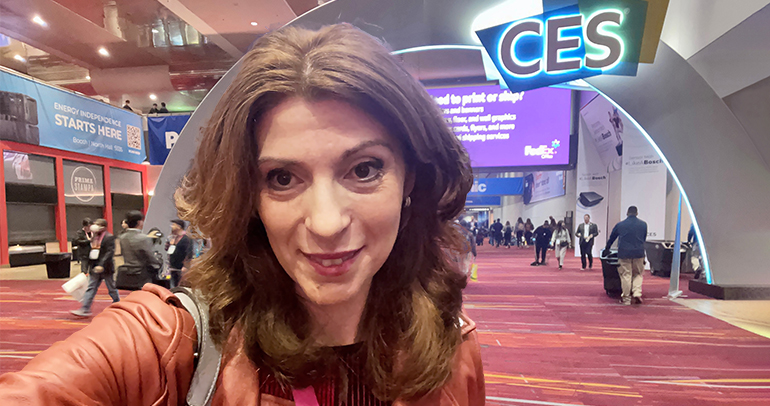
Are you ready for an experiment? Spend some time watching commercials during primetime TV, or while waiting to board your flight at the airport. In a matter of minutes, you will notice an ever-increasing number of impressive and exciting ads touting smart Internet of Things (IoT) technology. Whether it’s a lonely grandmother connecting with her far-away family, thanks to Alexa and the Amazon Echo Spot, or a busy father scouting Greek food locations with his LG OLED TV with Google Assistant, IoT devices are the present and future answer to consolidating seemingly endless daily tasks and helping consumers connect with family.
Rapid developments are present everywhere we turn. The 2018 Consumer Electronics Show (CES) featured a Smart Home Marketplace more advanced – and promising – than ever before. In addition to efficient and connection-based clocks and televisions, trusted brands like Kohler, Whirlpool, and Honeywell are showcasing retail innovations promising to make homes safer, healthier, and more comfortable.
Whether it’s a refrigerator reminding you that your apples and oranges are about to rot – or a connected dishwasher that starts rinsing your dirty china with a simple voice command – appliances and entertainment technology are joining the ranks of smart automobiles and security systems to become the assistants families and professionals didn’t know they needed.
In fact, a recent feature story in Forbes magazine spotlighted how the aforementioned “Alexa” of Amazon fame is now the latest virtual butler to cater to guests staying at Marriott-branded hotels.
“Customers tell us they love how easy it is to get information, enjoy entertainment and control connected devices by simply asking Alexa,” explained Amazon VP Daniel Rausch in the Forbes feature. “We want to offer those experiences everywhere customers want them.”
Consider how the world recently became captivated by the news that the Google Virtual Assistant had used an eerily human sounding voice (replete with “ums” and “ahhs”) to book a hair appointment by phone. Clearly, our ability to engage in multiple tasks at one time – while enjoying the experience – is advancing at a rapid pace that both shocks and delights the American and global consumer base.
From predictive data collection to nearly overnight developments in natural language processing, consumer-oriented brands in all industries are eager to capitalize off the many benefits these devices provide. While the technology is undoubtedly thrilling, the key for commercial enterprises is ensuring their customers understand it, then accept it as quickly as possible.
Top Factors Driving Smart IoT Devices & Consumer Adoption
To obtain wide acceptance, it is up to various industries, from automotive to healthcare to retail, to convince the public that these products are not only beneficial, but necessary. One of the easiest arguments to make to consumers is that it helps them save time while delivering a needed boost in a world of instant gratification. Though companies are finding ways to benefit on their end of the IoT paradigm, what will they need to overcome consumer resistance to giving up a modicum of privacy and control in order to foster wider adoption of the technologies?
1. Consumer Brand Loyalty
In a society dominated by brand loyalty, consumers want to know the trusted entities behind the technology – and these savvy virtual assistants. For example, Marriott’s Guestroom Innovation Lab collaborates with Samsung and Legrand to optimize their stay experience. As a result of this technology partnership, guests will interact with Bixby and store much of their data in the ARTIK platform and SmartThings cloud. Put simply, they must like and trust these brands to want to use them. This phenomenon extends across industries.
A family’s smart thermostat may be powered by Alexa, for example – but there still are a limited number of tasks the assistant can handle. If they do not enjoy using Alexa, their continued adoption of similar technology may dwindle. By the same regard, some products will be powered by Apple, while others will run on Google technology. Whether it is the voice assistant drivers used in their Toyota – or the underlying technology which powers the commands to control kitchen appliances, for example – helping consumers define the relationship between the perks of their devices and who drives them is key.
While it is possible enterprises will be overthinking consumer loyalty to Apple, Microsoft, or another entity, it will behoove them to help their buyers understand who is owning and collecting their data – and how it helps them to achieve their goals and complete daily tasks. In turn, the organizations creating the technology will benefit by hashing out how their devices and clouds interconnect.
2. Privacy Concerns and the Race for Data Collection
As alluded to previously, the battle is on for the ownership and collection of data by technology companies. The more information businesses have about people using smart IoT devices, the more they will be able to enhance consumer experience and dominate their marketplace. Like-minded, competitive organizations will not be sharing consumer data, so building trust matters. Autonomous vehicle manufacturers, smart television makers, and blue-chip appliance giants can be sure that their customers haven’t yet forgotten about the Facebook and Cambridge Analytica scandal – or the almost regular notices they receive about their data being included in a restaurant or bank data breach. It is how they handle consumer perception that will drive future adoption.
There are also concerns about IoT smart device spying – and the potential security risks that come with billions of cars, appliances, and entertainment products being connected by the year 2020. With this discussion, however, comes promise – the global market will grow to up to $475 billion by then – a Compound Annual Growth Rate (CAGR) of a whopping 28.5 percent.
3. Consumer Budgets, Product Lifecycles, and Device Efficiency
If you have ever had to argue with Siri to get an answer to a simple question, you know the first-hand limitations of smart tech. At a minimum, all devices need to learn from Google Virtual Assistant’s example – concisely understanding what the consumer is saying and using it to complete myriad tasks. Businesses will have to grapple with people who don’t want to adopt new or difficult technology, so ease of use is essential.
These factors intersect with consumer budget. When weighing benefits of smart IoT devices vs. price, difficulty or affordability of adoption may affect the speed at which the industry evolves. For example, a millennial who recently bought a 2016 KIA Soul has some voice capability in their car, but not the newest technology. While they may think new IoT innovations are neat, they are not going to necessarily invest in a new car until they finish making payments. At the point they buy a brand new vehicle, they will upgrade to the latest technology – and then learn how to use it. Many companies at CES argued about the impact price point will have in the speed of adoption – it will be less painful for consumers to buy a smart dishwasher or clock versus a $30,000 vehicle.
4. Global Adoption of Smart IoT
While it is relatively simple to predict the future of the smart IoT device industry in the fast-paced, instantly gratified United States, it is additionally important for large organizations to consider how the rest of the world deploys and utilizes the technology. While Apple, Google, and Amazon are among the most trusted and used brands in America, Asian and European consumers prefer South Korea’s Samsung and other local companies while Apple’s popularity declines in large markets like China.
Since there are various technological and societal dynamics across the world, companies interested in capitalizing off smart IoT devices must complete their due diligence via extensive and relevant research to understand the various marketplaces in which they compete.
5. Growing Consumer Industries by Leveraging the Benefits of IoT
Advancements in IoT devices are undoubtedly useful and exciting to both customers and consumer-based industries. However, it is up to the organizations creating innovative products to transform their knowledge about clients’ emotions, needs, and wants into a trust-building engagement strategy.
Automotive companies, for example, must learn how to balance headlines about self-driving car fatalities with public knowledge about the prevalence and usefulness of advanced driver assistance systems (ADAS), while large home appliance leaders should leverage data to overcome consumers’ inner battle between cost, budget, and benefit. No matter how advanced a TV or sedan becomes, consumer attitude will drive adoption. These organizations should focus on ways to engage their customer base to add context and establish the “why” factor in using their products.
It is the everyday mission of Escalent to assist companies in understanding these nuances through research about consumer habits to support the value proposition of their devices. The companies who currently make IoT devices are primarily focused on technological advancement and product features but ignore customer perception at their own peril. If enterprises can turn consumer data and sentiment into a strategy that delivers on promises of better efficiency and improved connectivity, the increase in global smart IoT will be coupled with a sentiment that consumers cannot live without it. The drive of habit change is trust – and research to inform development, implementation, and marketing strategies will bridge the gap.
If you would like to learn more about how you can best leverage consumer research to create products that delight your customers, click below to send us a note.








